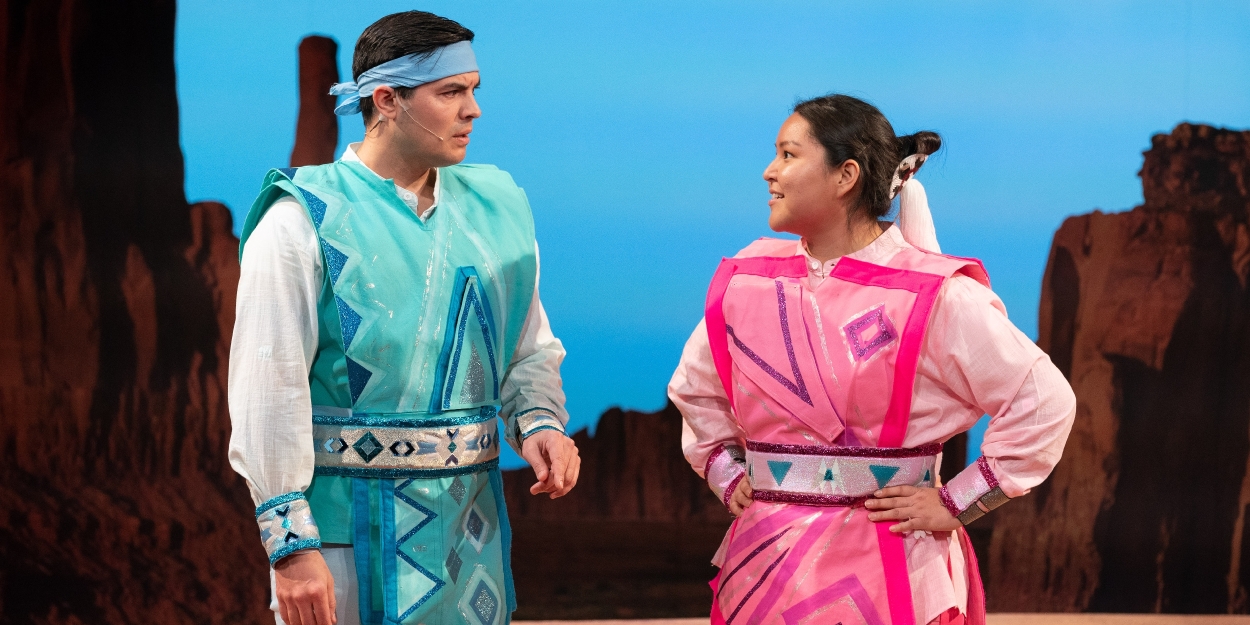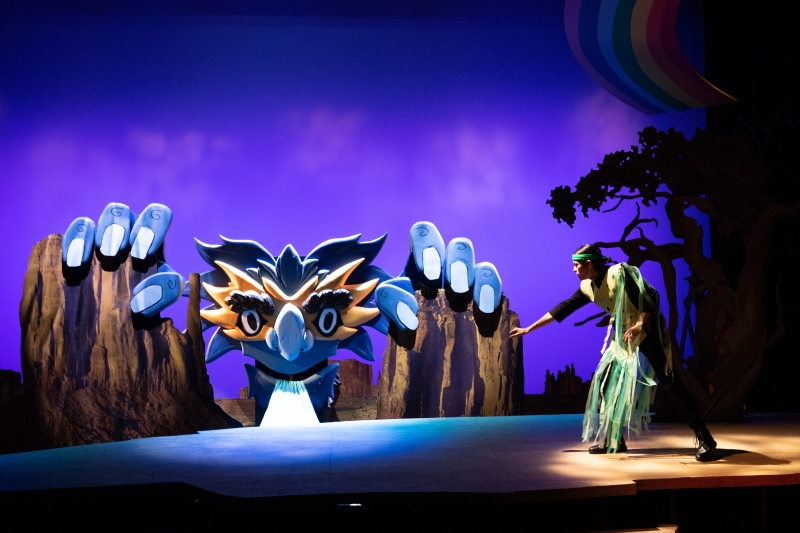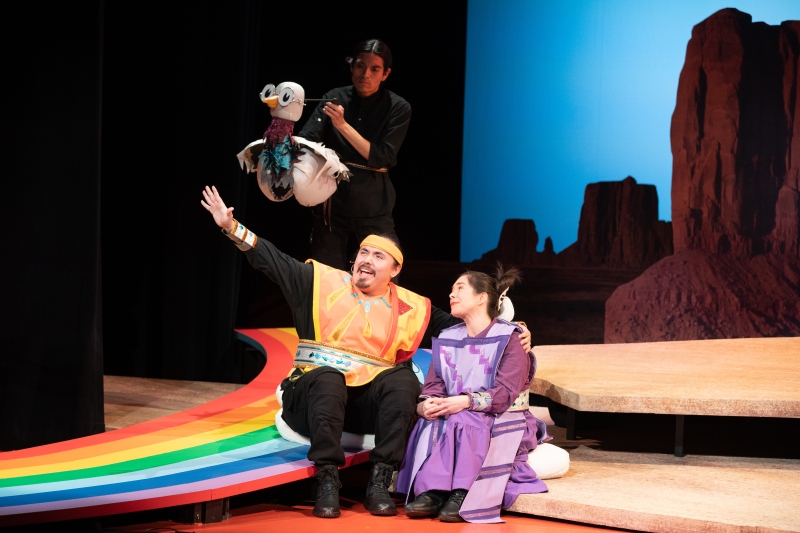Review: THE OTHER CHILDREN OF THE SUN at The Kennedy Center
The production runs through March 9th

Just weeks after Trump deposed much of The Kennedy Center's board of trustees and replaced them with his supporters (who subsequently elected him as the board's chair) and off the heels of the White House's statement that "The Kennedy Center learned the hard way that if you go woke," The Other Children of the Sun had its world premiere in the Family Theater to a warm and young audience.
The show is based on Navajo creation stories and celebrates Diné culture. It follows the story of Ánaaí (Derek Garza) and Adeezhí (Sienna Tso), brother and sister duo and children of Jóhonaa’éí (Kholan Studi), the sun. It opens big and bold, with an introduction to the earthly world of monsters. A massive puppet (puppets designed by Chamindika Wandurgala and Johnathan Boyd) of Yé’iitsoh, an evil people-eating monster, greets the audience with its booming voice and horrifying visage. It is quite the spectacle, and honestly pretty intimidating. Though surprisingly, there were no tears or outcries from the young theatergoers at the press performance on the 22nd. It is accompanied by narration from a personified/spirit of the Wind (Nikcoma Lee Mahkewa), who enthusiastically tells the audience the story of the Hero Twins, two young boys on a quest to save humanity and slay monsters. The narration is aided by charming and illustrative shadow puppets. The Wind then introduces our show's heroes, the siblings Ánaaí and Adeezhí.

The brother and sister are bored with their life, living up in the sky in the big turquoise house of their father, the sun. They complain about nothing ever happening, and while they complain, something does happen. Them and their mother, Shimá (Vicki Oceguera), meet some minor monsters before meeting Ánaaí and Adeezhí's brothers, the Hero Twins, who were on a mission to get weapons from their father, Jóhonaa’éí, to destroy the monsters relentlessly killing humanity. The minor monsters the family meet, as well as the Hero Twins themselves, are all puppets. The puppets of the show are charming—rustic in an endearing way. They have a papier-mâché appearance and function simply. Through their puppeteering and voicing, though, they become lively and expand the visual/material world of the show, becoming a highlight of the piece. The Hero Twins puppet is probably the most memorable (save for the massive and impressive Yé’iitsoh), and are puppeted by Johnathan Boyd, who really breathes life and humor into the puppet, as well as many others throughout the piece.
After exposure to their brave brothers and the earthly realm, the two siblings of the sky decide that they too should go on an adventure, and travel down to the Earth in search of monsters to slay. Their motivations are varied—they seem eager to explore the Earth, but also want to be like their brothers, who seem epic, brave, and adventurous. Herein lies the first of many internal family themes of the show—dealing with comparison between siblings. It explores in small ways how one feels when their sibling, or close family member is praised, or lauded, and how one may be eager to be like them, or receive the same praise, and all that may come with that. Similar themes of the show are actually quite mature. There is a plot-line involving the parents, Shimá and Jóhonaa’éí. After finding out that Jóhonaa’éí is the father of the Hero Twins, Shimá deals with a lot of unpleasant emotions. She "invents" jealousy and is very angry at Jóhonaa’éí for his lapse in faithfulness. A lot of the jokes regarding this plot-line are more directing at the parents, however, it is still a situation present in many households—animosity between parents. It is refreshing and perhaps even bold to so clearly show a home fractured by infidelity in a piece of theatre directing at such young an audience. The way the conflict is resolved is important too, though very angry at each other (and through a humorous counseling session with a pigeon) Shimá and Jóhonaa’éí try to communicate clearly and amend their situation through words and actions.
The parental conflict allows the kids to slip down to the Earth without being reprimanded, and it is here where the children meet the four monsters they are meant to kill—Hunger Man (Kholan Studi), the Innovative Rabbits (Nikcoma Lee Mahkewa), Old Age Bringer (Vicki Oceguera), and the Winter Woman (Nikcoma Lee Mahkewa). However, after encountering these so-called monsters the children learn that, though sometimes unpleasant, or uncomfortable, they are all necessary for human life. Hunger Man makes it so that humans know to eat, to nourish themselves, for example. The Winter Woman makes the Earth quiet and still so that it and its inhabitants can rest. Herein lies one of the main messages of the show. Young theater-goers learn that there are many things that are unpleasant, arduous, saddening, or boring in the world that are necessary, and make the things that they do enjoy possible, and all the sweeter.
Eventually the children are reunited with their parents, who were worried sick about them, and who deliver the other big message/lesson of the show. Jóhonaa’éí admits to only thinking about himself, and not considering how others felt, and that's how people get hurt. Though more of a comic character, it's moving to see such a strong character, the literal sun, admit his transgressions and express regret over hurting people. It's a good thing for young minds to internalize.
A larger and less explicit message of the show, though equally important (or perhaps the most important of the show in light of current circumstances) has to do with distance, fear, and perception. Ánaaí and Adeezhí realize that the only reason they viewed Hunger Man, the Innovative Rabbits, Old Age Bringer, and the Winter Woman as monsters is because they were told they were. Their perception of these beings led to immense unfounded fear, which caused them to seek out violence. Their distance from the earthly realm allowed them to be unaware of the strife and suffering happening there. It is an apt and important commentary on how groups of people view each other, and how easy it is to allow fear, distance, and misunderstanding to motivate you, or push you into unnecessary and targeted violence. While none of this is explicit, it is monumentally important that children internalize these messages. Rhiana Yazzie, the playwright and director of the piece presented these themes in messages in age-appropriate, entertaining and humorous fashion.
The show is also a great opportunity to expose young ones to Diné culture, and celebrate the work and stories of Native people. The entire cast is made up of native folks, and the visual world of the show (costumes, sets, etc.) reflect Diné material culture. The show starts with a land acknowledgement, which regardless of opinion on seems appropriate and apt for this piece. The house announcement also explicitly asks questions of the audience before the show starts, which is a great way to encourage young minds (and old ones, too) to consider how they engage with the piece, and think critically about what they are shown, rather than just blindly consuming something. And while it may be daunting for a young one to tackle that all on their own, the show provides an excellent opportunity to for their adults to facilitate those conversations with them.
And while the aforementioned themes and messages of the show may seem potentially hard for children to access, the show does a great job of holding their attention. The humor is suited for the demographic, though at times funny for the adults in the room as well. The bright and vibrant setting (lighting by Colin K. Bills and scenic design by Misha Kachman) is sure to excite young ones with its rainbows and desert terrain. The use of bogos (or perhaps some other technique) to create white puffy clouds was particularly effective. The costumes, which are light and bright, serve, as mentioned above, to reflect Diné culture, but also to engage young ones.
Ánaaí and Adeezhí's costumes seem to be made to look almost superhero-y. The promotional art for the show also depicts the two in superhero fashion, flying through the sky, and text from the Kennedy Center mentions that this is a superhero adventure. The show seems to be reinterpreting conventional superhero tropes and conventions, which is refreshing in an age of Marvel oversaturation, however a young one promised a superhero experience may not get quite what they expect.

Yazzie's piece is playful and important. It most certainly exists outside the current controversies of the Kennedy Center, and Yazzie and the cast/crew should certainly not be overshadowed by the happenings there. However, with the context of the current goings-on and in light of the aforementioned White House comments about "woke," etc., it is apparent that should you have young ones at home, rushing them to shows like this is more important than ever.
A spirited and fun theater-outing, The Other Children of the Sun is just what young ones need these days. Information on tickets, including sensory friendly performances, can be found on the Kennedy Center's website. The show runs for about 65 minutes without an intermission. It is part of the Theater for Young Audiences BIPOC Superhero Project and was commissioned by the Kennedy Center.
Reader Reviews
Videos

